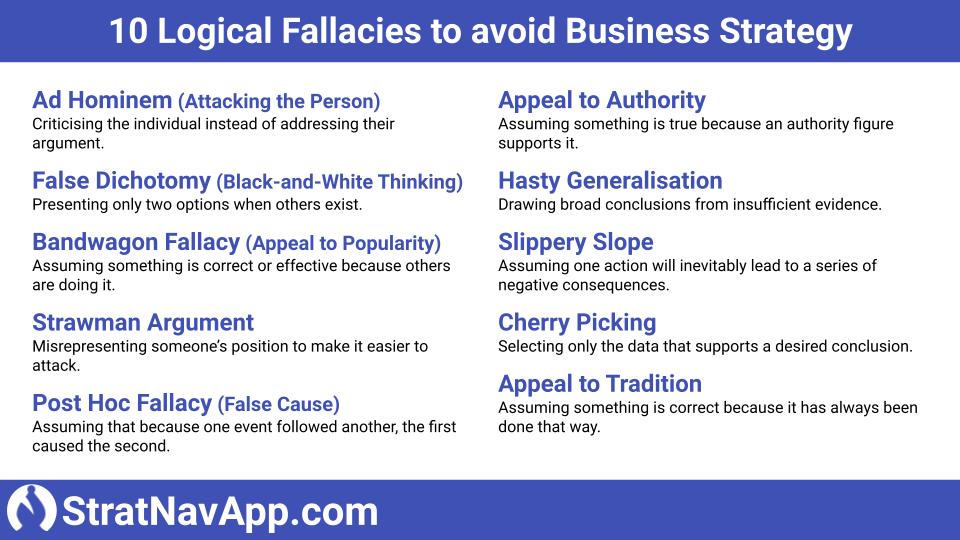 Making sound decisions is at the heart of effective business strategy. But even seasoned leaders can fall prey to flawed reasoning—logical fallacies—that derail strategic thinking. Recognising and overcoming these fallacies is essential for building resilient strategies and avoiding costly mistakes.
Making sound decisions is at the heart of effective business strategy. But even seasoned leaders can fall prey to flawed reasoning—logical fallacies—that derail strategic thinking. Recognising and overcoming these fallacies is essential for building resilient strategies and avoiding costly mistakes.
10 Common Logical Fallacies in Business Strategy
Here are 10 common logical fallacies in business strategy, how they arise, and how to counteract them.
Ad Hominem (Attacking the Person)
- What It Is: Criticising the individual instead of addressing their argument.
- Where It Arises: In strategy discussions, dismissing ideas based on the person proposing them rather than their merits.
- Example: "We can’t implement her idea; she’s new to the team."
- How to Overcome: Focus on the content of the argument, not the individual presenting it. Ask: “What are the merits of this idea?”
False Dichotomy (Black-and-White Thinking)
- What It Is: Presenting only two options when others exist.
- Where It Arises: In strategic planning, framing decisions as all-or-nothing.
- Example: "We either expand globally or risk stagnation."
- How to Overcome: Explore a spectrum of options. Ask: “What other strategies could address our goals?”
Bandwagon Fallacy (Appeal to Popularity)
- What It Is: Assuming something is correct or effective because others are doing it.
- Where It Arises: Copying competitors without understanding their context.
- Example: "Our competitors are adopting AI; we should too."
- How to Overcome: Assess whether a trend aligns with your objectives and capabilities. Ask: “Does this fit our unique strategic needs?”
Strawman Argument
- What It Is: Misrepresenting someone’s position to make it easier to attack.
- Where It Arises: Misinterpreting objections to new strategies.
- Example: "If we cut costs, they think we’ll go bankrupt!"
- How to Overcome: Seek to understand opposing views fully. Ask: “What’s the strongest version of this objection?”
Post Hoc Fallacy (False Cause)
- What It Is: Assuming that because one event followed another, the first caused the second.
- Where It Arises: Misinterpreting market changes or performance data.
- Example: "Sales improved after the rebrand, so the rebrand caused the improvement."
- How to Overcome: Use data to identify causal relationships. Ask: “What other factors could explain this outcome?”
Appeal to Authority
- What It Is: Assuming something is true because an authority figure supports it.
- Where It Arises: Following advice from prominent voices without scrutiny.
- Example: "This strategy will work because a famous CEO used it."
- How to Overcome: Evaluate the evidence behind recommendations. Ask: “What makes this relevant to our situation?”
Hasty Generalisation
- What It Is: Drawing broad conclusions from insufficient evidence.
- Where It Arises: Misinterpreting early trends or pilot results.
- Example: "Our first customer loved the product, so it’ll be a hit!"
- How to Overcome: Gather a representative sample of data. Ask: “Do we have enough evidence to generalise?”
Slippery Slope
- What It Is: Assuming one action will inevitably lead to a series of negative consequences.
- Where It Arises: Resistance to innovation or change.
- Example: "If we allow remote work, productivity will plummet, and we’ll lose clients."
- How to Overcome: Examine each step logically. Ask: “Is there evidence to support this chain of events?”
Cherry Picking
- What It Is: Selecting only the data that supports a desired conclusion.
- Where It Arises: In strategy presentations or performance reviews.
- Example: "Our revenue increased this quarter, so our strategy is working!" (ignoring rising costs).
- How to Overcome: Use comprehensive data sets. Ask: “What are we leaving out?”
Appeal to Tradition
- What It Is: Assuming something is correct because it has always been done that way.
- Where It Arises: Resistance to modernising operations or adopting new technology.
- Example: "We’ve always used this approach, and it’s worked so far."
- How to Overcome: Balance tradition with innovation. Ask: “Does this approach still serve our goals?”
Why It Matters
Logical fallacies can subtly influence business strategies, leading to flawed decisions that waste resources or create unnecessary risks. By recognising these common pitfalls, leaders can foster critical thinking, encourage productive debate, and build strategies rooted in sound reasoning.
Practical Tips to Avoid Logical Fallacies
- Encourage Diverse Perspectives: Broaden discussions to counter bias.
- Use Data Wisely: Ensure decisions are evidence-based and not anecdotal.
- Ask Better Questions: Challenge assumptions and dig deeper into reasoning.
- Foster a Culture of Reflection: Regularly review strategic decisions for underlying fallacies.
By being vigilant about logical fallacies, you can strengthen your business strategy and make smarter, more impactful decisions.

